General Sir John Monash, Personal Files Book 19, 4 June - 24 June 1918, Part 4
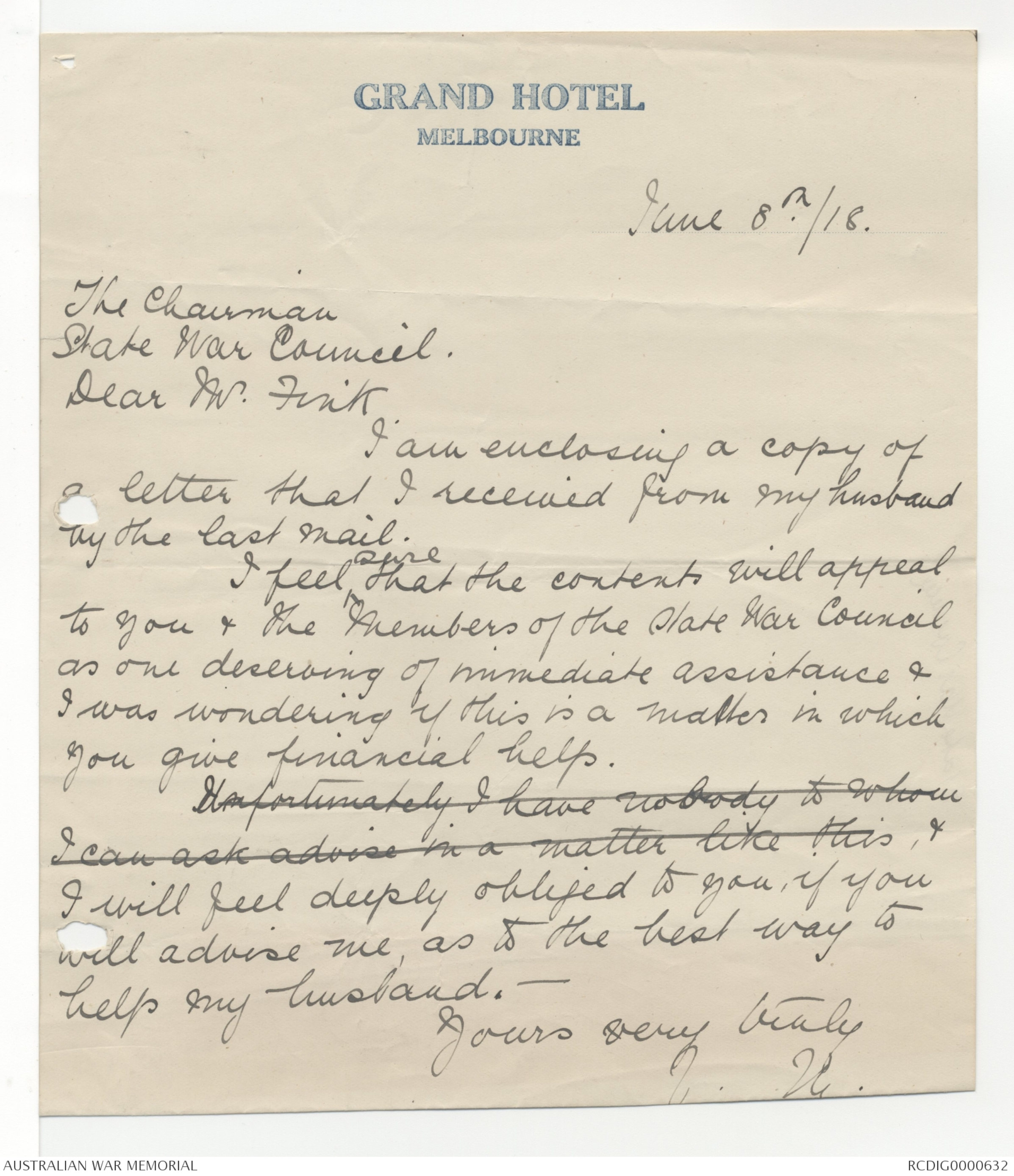
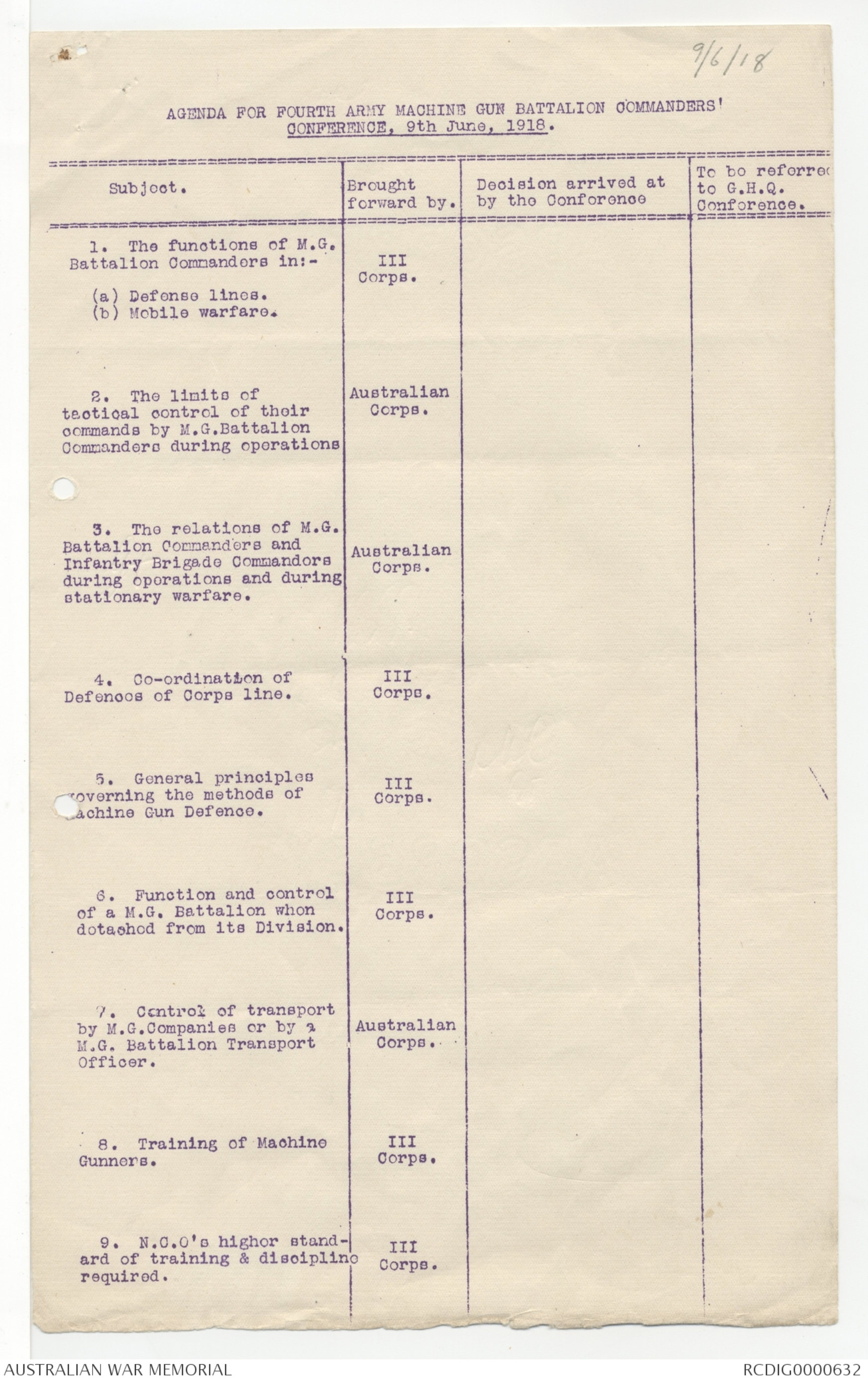
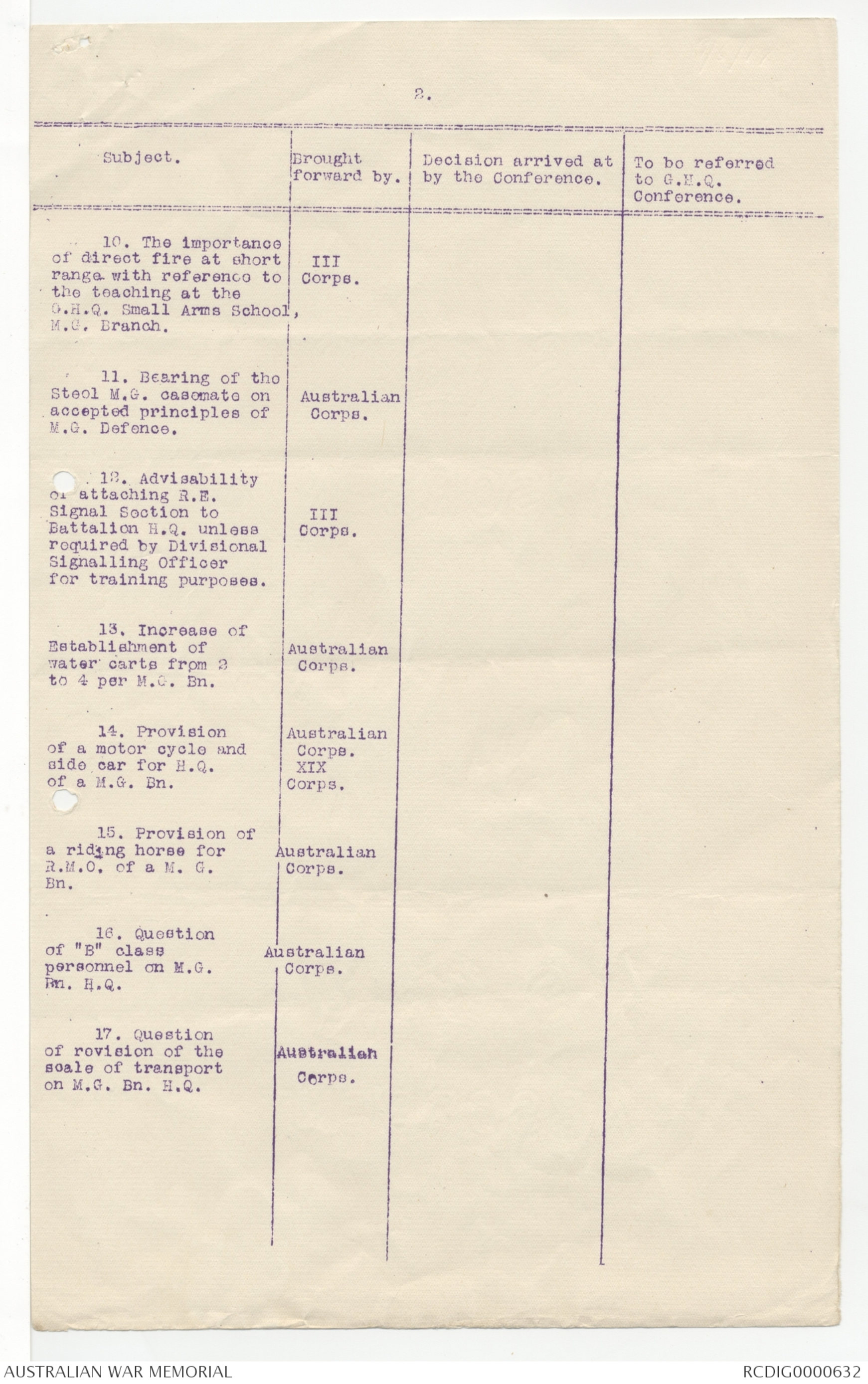
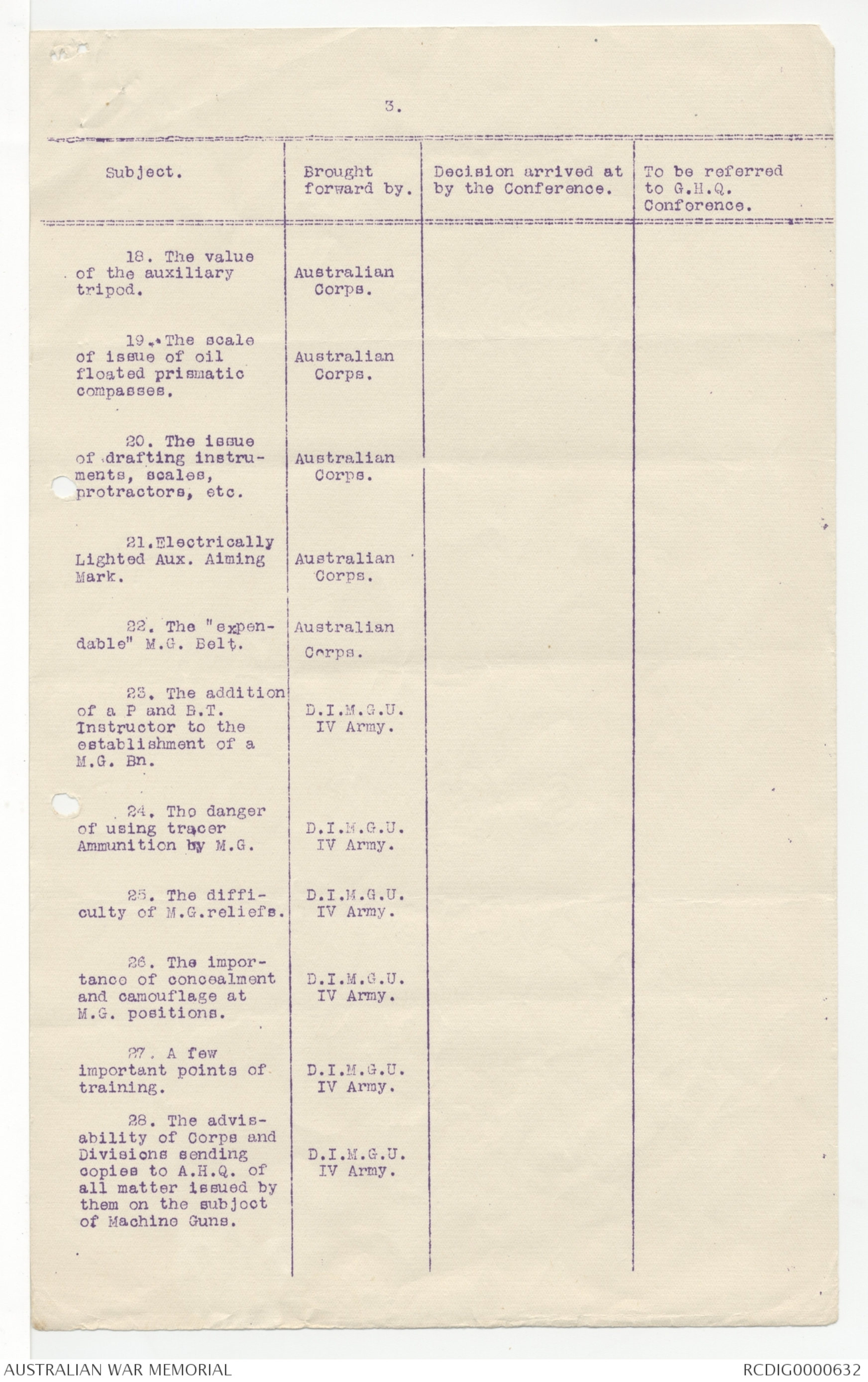
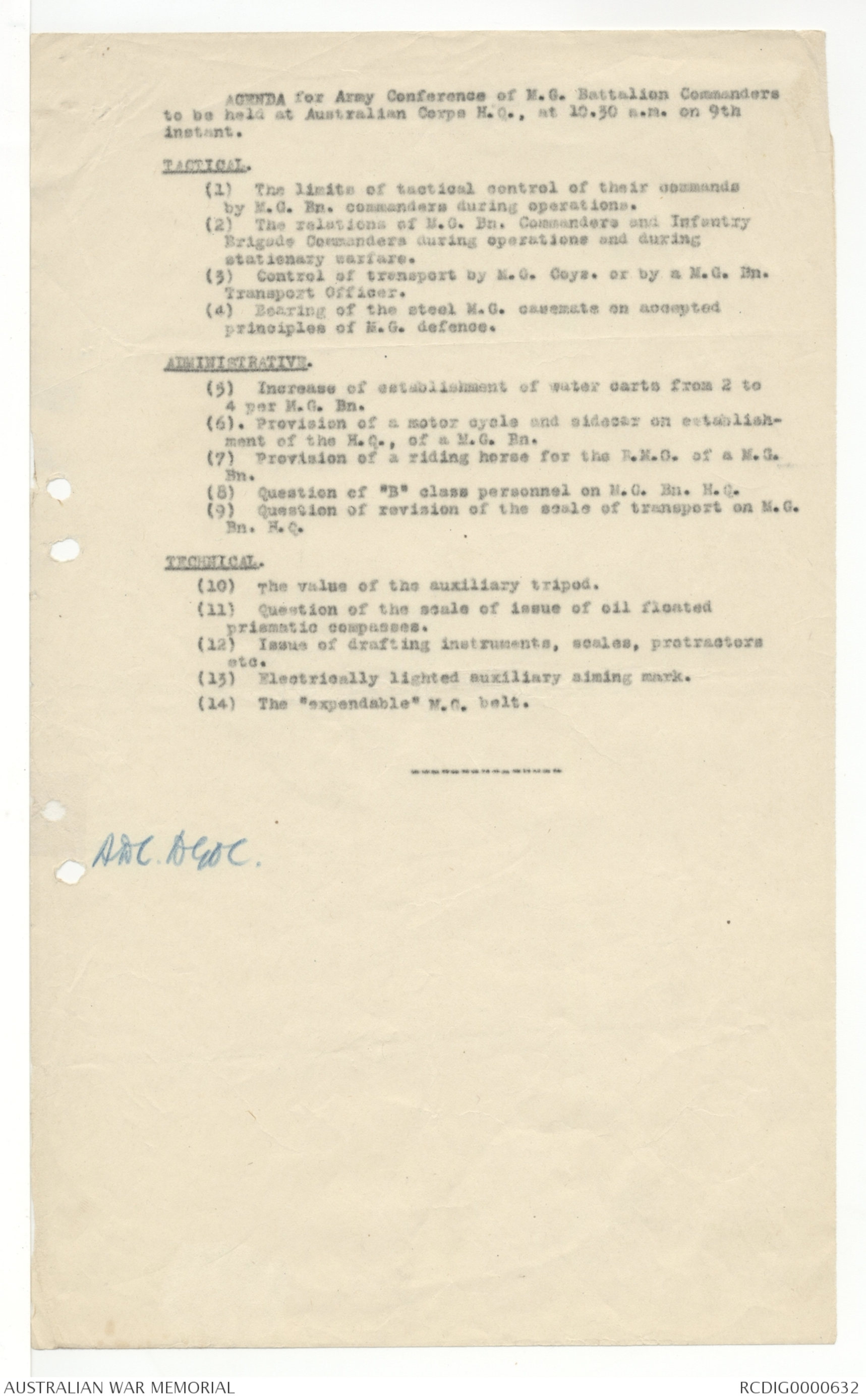
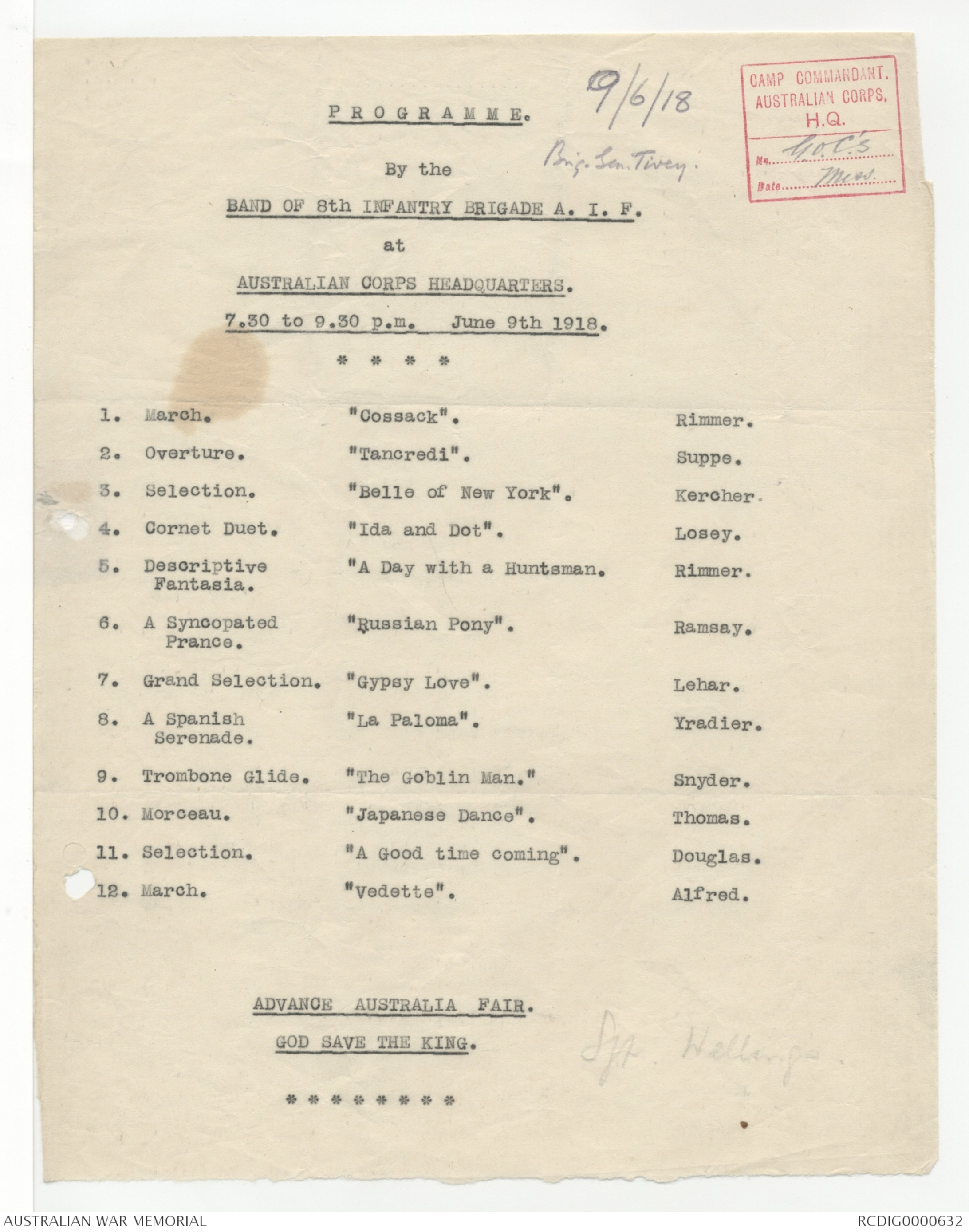
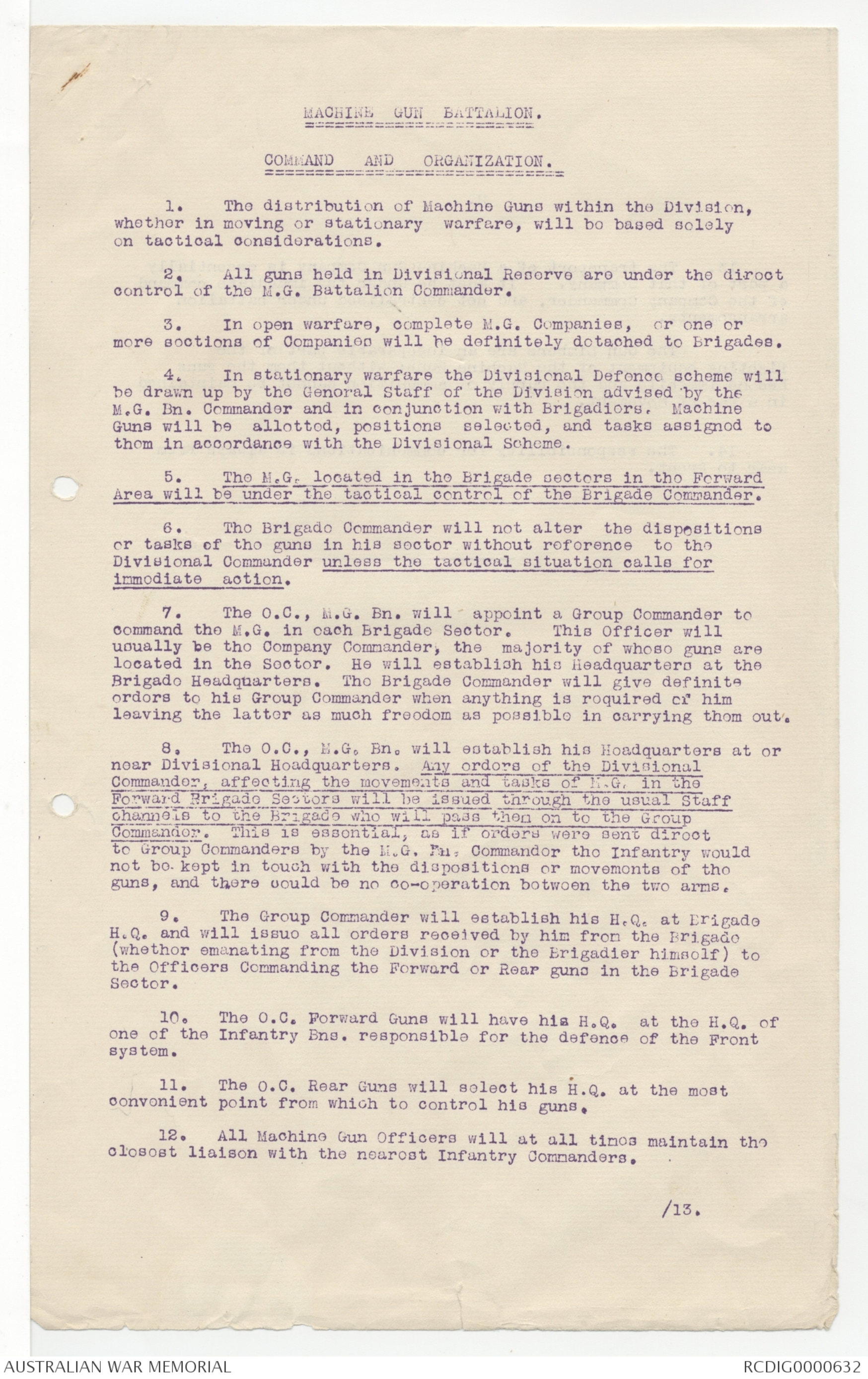
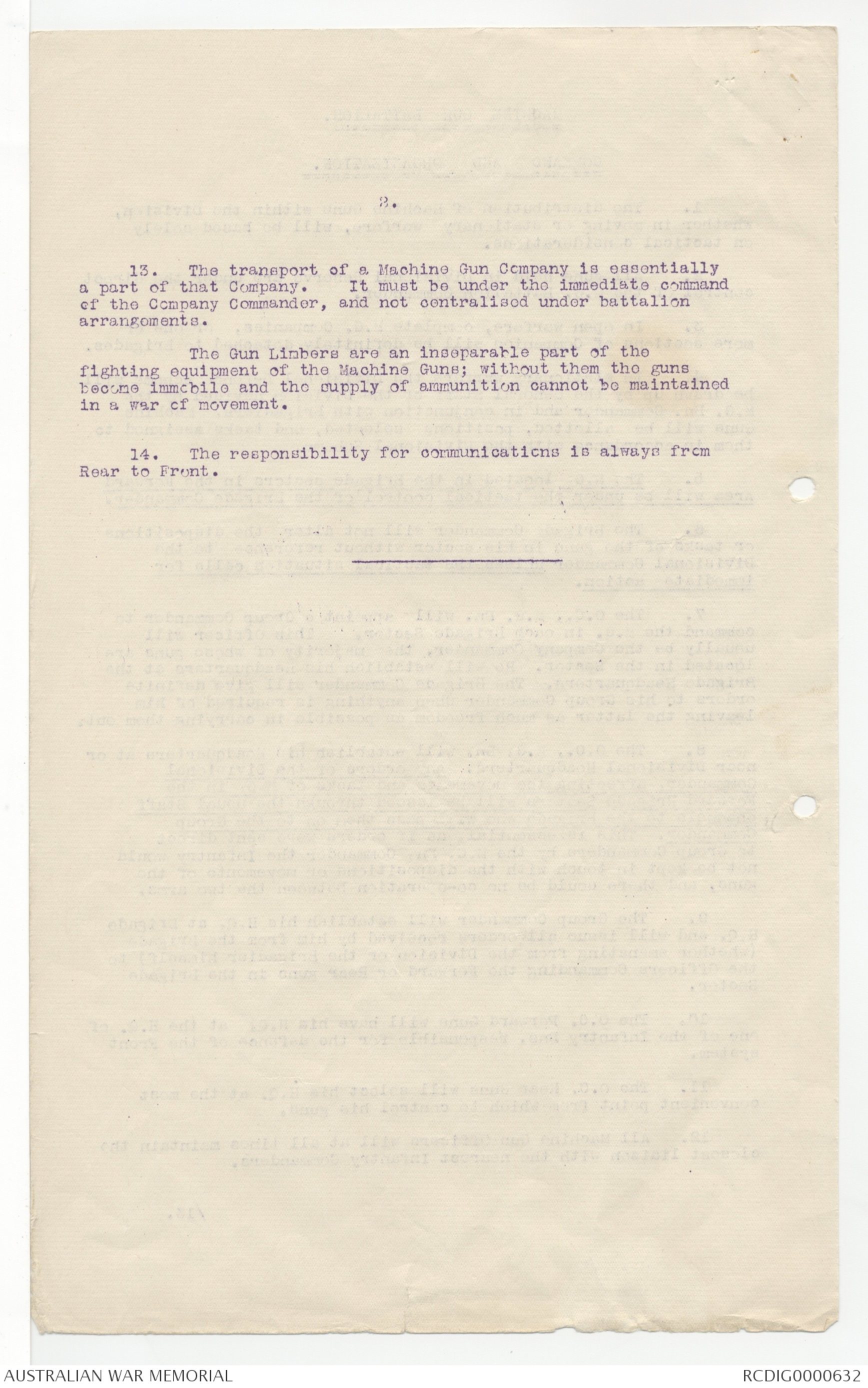
GRAND HOTEL
MELBOURNE
June 8th/18
The Chairman
State War Council.
Dear Mr. Fink.
I am enclosing a copy of
a letter that I received from my hisband
by the last mail.
I feel ^sure that the contents will appeal
to you & the Members of the State War Council
as one deserving of immediate assistance &
I was wondering if this is a matter in which
you give financial help.
Unfortunatley I have noboy to whom
I can ask advice in a matter like this, &
I feel deeply obliged to you, if you
will advise me, as to the best way to
help my husband. -
Yours very truely
[[?]]
9/6/18
AGENDA FOR FOURTH ARMY MACHINE GUN BATTALION COMMANDERS'
CONFERENCE, 9TH JUNE, 1918.
| Subject. |
Brought forward by. |
Decision arrived at by the Conference |
To be referred to G.H.Q. Conference. |
Battalion Commanders in:- (a) Defence lines. (b) Mobile warfare. |
III Corps. |
||
|
2. The limits of tactical control of their commands by M.G.Battalion Commanders during operations |
Australian Corps. |
||
|
3. The relations of M.G. Battalion Commanders and Infantry Brigade Commanders during operations and during stationary warfare. |
Australian Corps. |
||
|
4. Co-ordination of Defences of Corps line. |
III Corps. |
||
|
5. General principles governing the methods of Machine Gun Defence. |
III Corps. |
||
|
6. Function and control of a M.G. Battalion when detached from its Division. |
III Corps. |
||
|
7. Control of transport by M.G.Companies or by a M.G. Battalion Transport Officer. |
Australia Corps. |
||
|
8. Training pf Machine Gunners. |
III Corps. |
||
|
9. N.C.O's higher standard of training & discipline required. |
III Corps. |
2.
| Subject. |
Brought forward by. |
Decision arrived at by the Conference. |
To be referred to G.H.Q. Conference. |
|
10. The importance of direct fire at short range with reference to the teaching at the G.H.Q. Small Arms School, M.G. Branch. |
III Corps. |
||
|
11. Bearing of the Steol M.G. casemate on accepted principles of M.G.Defence. |
Australian Corps. |
||
|
12.Advisability of attaching R.E. Signal Section to Battalion H.Q. unless required by Divisional Signalling Officer for training purposes. |
III Corps. |
||
|
13. Increase of Establishment of water carts from 2 to 4 per M.G. Bn. |
Australian Corps. |
||
|
14. Provision of a motor cycle and side car for H.Q. of a M.G.Bn. |
Australian Corps. |
||
|
15. Provision of riding horse for R.M.O. of a M.G. Bn. |
Australian Corps. |
||
|
16. Question of "B" class personnel on M.G. Bn. H.Q. |
Australian Corps. |
||
|
17. Question of revision of the scale of transport on M.G. Bn. H.Q. |
Australian Corps. |
3.
| Subject. |
Brought forward by. |
Decision arrived at by the Conference. |
To be referred to G.H.Q. Conference. |
|
18. The value of the auxiliary tripod. |
Australian Corps. |
||
|
19. The scale of issue of oil floated prismatic compasses. |
Australian Corps. |
||
|
20. The issue of drafting instruments, scales, protractors, etc. |
Australian Corps. |
||
|
21. Electrically Lighted Aux. Aiming Mark. |
Australian Corps. |
||
|
22. The "expendable" M.G. Belt. |
Australian Corps. |
||
|
23. The addition of a P and B.T. Instructor to the establishement of a M.G. Bn. |
D.I.M.G.U. IV Army. |
|
|
|
24. The danger of using tracer Ammunition by M.G. |
D.I.M.G.U. IV Army. |
|
|
|
25. The difficulty of M.G.reliefs. |
D.I.M.G.U. IV Army. |
|
|
|
26. The importance of concealment and camouflage at M.G. positions. |
D.I.M.G.U. IV Army. |
|
|
|
27. A few important points of training. |
D.I.M.G.U. IV Army. |
|
|
|
26. The advisability of Corps and Divisions sending copies of A.H.Q. of all matter issued by them on the subject of Machine Guns. |
D.I.M.G.U. IV Army. |
|
AGENDA for Army Conference of M.G. Battalion Commanders
to be held at Australian Corps H.Q., at 10.30 a.m. on 9th
instance.
TACTICAL.
(1) The limits of tactical control of their commands
by M.G. Bn. commanders during operations.
(2) The relations of M.G. Bn. Commanders and Infantry
Brigade Commanders during operations and during
stationary warfare.
(3) Control of transport by M.G. Coys. or by a M.G. Bn.
Transport Officer.
(4) Bearing of the steel M.G. casemate on accepted
principles of M.G. defence.
ADMINISTRATIVE.
(5) Increase of establishment of water carts from 2 to
4 per M.G. Bn.
(6). Provision of a motor cycle and sidecar on establishment
of the H.Q., of a M.G. Bn.
(7) Provision of a riding horse for the R.M.O. of a M.G.
Bn.
(8) Provision of "B" class personnel on M.G. Bn. H.Q.
(9) Question of revision of the scale of transport on M.G.
Bn. H.Q.
TECHNICAL.
(10) the value of the auxiliary tripod.
(11) Question of the scale of issue of oil floated
prismatic compassses.
(12) Issue of drafting instruments, scales, protractors
etc.
(13) Electrically lighted auxiliary aiming mark.
(14) The "expendable" M.G. belt.
---------------------------------
ADC. DGOC.
CAMP COMMANDANT.
AUSTRALIAN CORPS.
H.Q.
No........G.O.C.'s
Date....Mess
9/6/18
Brig. Gen. Tivey.
PROGRAMME.
By the
BAND OF THE 8th INFANTRY BRIGADE A.I.F.
at
AUSTRALIAN CORPS HEADQUARTERS.
7.30 to 9.30 p.m. June 9th 1918.
* * * *
|
"Cossack" | Rimmer. |
| 2. Overture. | "Tancredi". | Suppe. |
| 3. Selection. | "Belle of New York". | Kercher. |
| 4. Cornet Duet. | "Ida and Dot". | Losey. |
|
5. Descriptive Fantasia. |
"A Day with a Huntsman. | RImmer. |
|
6. A Syncopated Prance. |
"Russian Pony". | Ramsay. |
| 7. Grand Selection. | "Gypsy Love". | Lehar. |
|
8. A Spanish Serenade. |
"La Paloma". | Yradier. |
| 9. Trombone Glide. | "The Goblin Man." | Snyder. |
| 10. Morceau. | "Japanese Dance". | Thomas. |
| 11. Selection. | "A Good time coming". | Douglas. |
| 12. March. | "Vedette". | Alfred. |
ADVANCE AUSTRALIAN FAIR.
GOD SAVE THE KING.
* * * * * * * *
Sgd Wellings
MACHINE GUN BATTALION.
COMMAND AND ORGANIZATION.
- The distribution of Machine Guns within the Division,
whether in moving or stationary warfare, will be based solely
on tactical considerations.
2. All guns held in Divisional Reserve are under the direct
control of the M.G. Battalion Commander.
3. In open warfare, complete M.G. Companies, or one or
more sections of Companies wil be definitely detached to Brigades.
4. In stationary warfare the Divisional Defence scheme will
be drawn up by the General Staff of the Division advised by the
M.G. Bn. Commander and in conjunction with the Brigadiers. Machine
Guns will be allotted, postions selected, and tasks assigned to
them in accordance with the Divisional Scheme.
5. The M.G. located in the Brigade sectors in the Forward
Area will be under the tactical control of the Brigade Commander.
6. The Brigade Commander will not alter the dispositions
or tasks of the guns in his sector without reference to the
Divisional Commander unless the tactical situation calls for immediate action.
7. The O.C., M.G. Bn. will appoint a Group Commander to
command the M.G. in each Brigade Sector. This Officer will
usually be the Company Commander, the majority of whose guns are
located in the Sector. He will establish his Headquarters at the
Brigade Headquarters. The Brigade Commander will give definite
orders to his Group Commander when anything is required of him
leaving the latter as much freedom as possible in carrying them out.
8. The O.C., M.G. Bn. will establish his Headquarters at or
near Divisional Headquarters. Any orders of the Divisional
Commander, affecting the movements and tasks of M.G. in the
Forward Brigade Sectors will be issued through the usual Staff
Commander. This is essential, as if orderers were sent direct
to Group Commanders by the M.G. Bn. Commander the Infantry would
not be kept in touch with the dispositions or movements of the
guns, and there could be no co-operation beetween the two arms.
9. The Group Commander will establish his H.Q. at Brigade
H.Q. and will issue all orders received by him from the Brigade
(whether emenating from the Division or the Brigadier himself) to
the Officers Commanding the Forward or Rear guns in the Brigade
Sector.
10. The O.C. Forward Guns will have his H.Q. at the H.Q. of
one of the Infantry Bns. responsible for the defence of the
Front system.
11. The O.C. Rear Guns will select his H.Q. at the most
convenient point from which to control his guns.
12. All Machine Gun Officers will at all times maintain the
closest liason with the nearest Infantry COmmanders.
/13.
2.
13. The transport of a Machine Gun Company is essentially
a part of that Company. It must be under the immediate command
of the Company Commander, and not centralised under battalion
arrangments.
The Gun Limbers are an inseparable part of the
fighting equipement of the Machine Guns; without them the guns
become immobile and the supply of ammunition cannot be maintained
in the war of mevment.
14. The responsibility for communitcation is always from
Read to Front.
 Sam scott
Sam scottThis transcription item is now locked to you for editing. To release the lock either Save your changes or Cancel.
This lock will be automatically released after 60 minutes of inactivity.